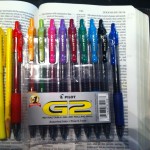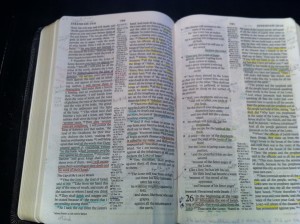As I read the Bible, I try to make note of repeated words, resumed themes, quotations of earlier passages, and other key ideas. I don’t want simply to see them, however, and move on. I want to mark them so that when I later have a vague recollection of something I read a while ago I can go back and find it.
So as I read the Bible, I use a mechanical pencil, a set of colored pens, colored pencils, and occasionally a highlighter to note things. As I’ve done this over the years, I’ve developed a color code for key ideas that breaks down like this:
 Orange = references to God’s glory or name
Orange = references to God’s glory or name
Green = references to earlier Scripture, whether quotations or otherwise
Purple = references to royalty/kingship/the coming Messiah
Red = anything notable, but particularly the actions the Lord himself does
Blue = references to faith, believing, piety, etc.
Pink = knowing or fearing God/the Lord
Yellow (colored pencil) = anything notable, repeated words in the passage, etc.
Brown (colored pencil) = references to times or dates
Mechanical Pencil = notes in the margin, underlines, connecting lines, etc.
Those are the constants. Some colors vary from book to book, but these are pretty standard throughout. For instance, I recently re-read Proverbs all at one sitting with the intention of noting everything the book says about raising children. I marked all those references with a lime green color, and all the references to the “path” of the righteous or to the “ways” of a man with an aqua green color. And since Proverbs has a few unique “headings” (1:1; 10:1; 22:17; 24:23; 25:1; 30:1; 31:1) I used a highlighter to mark those. Bible pages tend to be thin, so I try to keep a highlighter that is almost used up to try to cut down on the bleed-through affect.
 So here’s a shot of a passage before I studied it and marked it up. I was preaching through Jeremiah, and the marked passage in the column on the far left ends at Jeremiah 25:14, which was where my last sermon on Jeremiah ended. I took this photo right before I began to study Jeremiah 25:15–38, which was the next sermon in the series on Jeremiah. This passage begins at the bottom of the far left column and continues through the two columns in the middle. I had already underlined Jeremiah 26:1 in brown colored pencil because it has a statement about when Jeremiah got this word, and the green colored pencil is there because of the reference to the way the word came from the Lord.
So here’s a shot of a passage before I studied it and marked it up. I was preaching through Jeremiah, and the marked passage in the column on the far left ends at Jeremiah 25:14, which was where my last sermon on Jeremiah ended. I took this photo right before I began to study Jeremiah 25:15–38, which was the next sermon in the series on Jeremiah. This passage begins at the bottom of the far left column and continues through the two columns in the middle. I had already underlined Jeremiah 26:1 in brown colored pencil because it has a statement about when Jeremiah got this word, and the green colored pencil is there because of the reference to the way the word came from the Lord.
As I worked through the passage, I underlined all the places where Jeremiah has something like “Thus says the Lord” in green colored pencil (see 25:15, 27, 29, 31, 32).
Then as I read and re-read the passage, I noticed that in both 25:16 and 27 Jeremiah is told to command the nations to “drink . . . because of the sword that I [Yahweh] am sending among you,” so I underlined the matching phrases in the two verses with an aqua green colored pencil.
Cities and nations are listed out in Jeremiah 25:18–26, with some comments on each. So I underlined each city or nation mentioned in yellow colored pencil.
Jerusalem was to be a city that reflected Yahweh’s glory, from which his glory radiated outward, so I underlined the reference in Jeremiah 25:29 to “the city that is called by my name” in orange pen.
In Jeremiah 25:30 the Lord twice roars like a lion, and I’ve circled those in mechanical pencil, drawing a line from that verse to 25:38, where similar imagery is used, and noting that Yahweh also roars like a lion in Amos 1:2, Joel 3:16, and Hosea 5:14.
I have also noted the next to Jeremiah 25:33 places where Jeremiah says similar things at 16:4 and 8:2.
Then in Jeremiah 25:34–36 there are several references to the “shepherds” who are the “lords of the flock,” and these are underlined in jade green colored pencil. The two calls for these wicked leaders of Israel to “wail” are underlined with a mechanical pencil, with a line connecting them. Here’s a photo of the page I’ve been describing:
I’ve marked up several copies of the Bible this way, and when I teach I want to have a copy of the Bible in front of me that has everything that I will have a faint memory of clearly marked so that I can find it (relatively) quickly when I’m asked a question, and I know I read something about that around Luke 12. I flip to Luke 12, and I can usually find what it was I had in mind because I usually remember, however faintly, what I’ve marked.
If I want an uninfluenced, fresh reading of the text, I can read a Bible that I haven’t marked up. But if I want to layer reading upon reading and go deeper this time than last, it helps me to read a copy that will have my previous study notes in it.
I recommend reading large chunks of Bible all at one sitting, whole books if possible, thoroughly marking them up as you go. Doing this book after book helps us see the interconnectedness of individual books and the thick intertextuality of each book of the Bible with all the others. Obviously you don’t have to do it exactly the way I do, but perhaps my method will spur your own thinking and you can adapt it to suit your own study.
Mark well what you read, and may the Word of Christ dwell in you richly (Col 3:16).
—-
This post originally appeared at Christianity.com.

Seems an awful lot is built off of a faulty understanding of Proverbs 22:6.
Voddie Baucham provides extended critique of Pearl’s book in Family Shepherds on pgs. 116-118, even arguing that Pearl espouses a semi-pelagion view of the nature of man. He pulled it off the tables at his church.
Its great to read that someone marks their bible as I do! Its also encouraging to discover that, even you Jim, have “vauge” recollections of passages. Many crucial passages I know by where on the page they are highlighted or marked in my Bible.
Look forward to hearing you this weekend at THINK13
How I Mark My Bible By @Drjimhamilton
http://t.co/N89vQcFJvh
How I Mark My Bible http://t.co/CETIVVGo06
How I Mark My Bible | Good advice from a veteran in the ministry | http://t.co/Mpea6pONGh
I just bought a new Bible and set of pens and have come up with a similar system I’ll try out soon. Would you be interested in posting a few more pictures of underlined pages?
what book is used in these pictures?? I love your ideas with highlighting and underlining I am going to implement these techniques in my bible. thanks for sharing!! please email about my question :))
ESV Classic Reference Edition